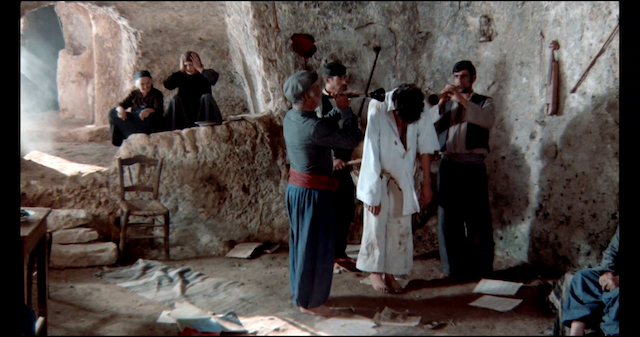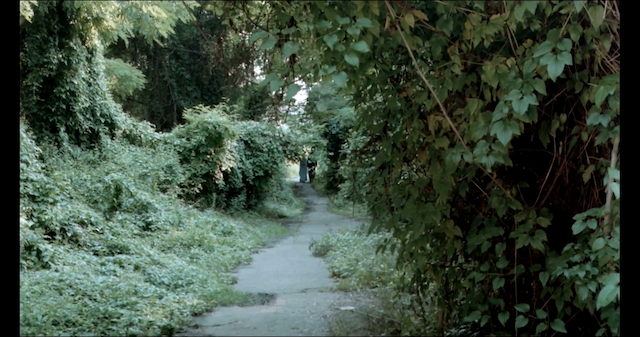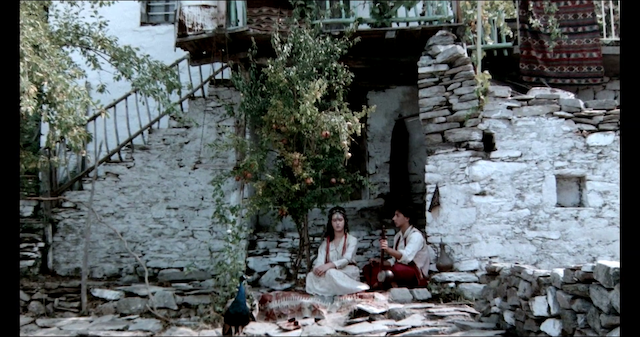Don Askarian – Komitas (1989)


The film is dedicated to the Armenian monk and genius composer Komitas, and the 2 million victims on his people in Turkey in 1915. The final 20 years of Komitas life were spent in various mental hospitals. The destiny of Komitas? This is the magic beauty of Armenian culture and the abhorrent brutality of Armenian history. A cultural and artistic world that was slaughtered with a curved knife. A humanity that doggedly advances towards an apocalyptic catastrophe, that does not recognize its own original purpose, eradicates its own memory, its final roots.
The Harvard Film Archive about the film: The monk Soghomon Soghomonian, known as Komitas, was a renowned Armenian composer and conductor who became a symbol of Armenian cultural unity through his orchestral and choral performances and his late nineteenth-century travels throughout the countryside, in which he collected peasant songs for generations eager to preserve their cultural heritage. In 1915, however, the musician’s career ended abruptly after a nervous breakdown precipitated by the Ottoman Empire’s devastation of an estimated three-fourths of the country’s population. Wracked with pain and subjected to the abuses of nineteenth-century psychiatric hospitals, Komitas lost his mind and withdrew into his own world of tortured memories for more than twenty years. Director Askarian dedicates his beautifully constructed, ambitious, and impressionistic portrait of Komitas to those who lost their lives.
Don Askarian on his film: Guided by pain, l extend my hand and it thrusts against them. The souls of 2 million murdered circle over your and my head, over Ararat… Tobacco, from which the “Camel” cigarette has been made, that l am just lighting, reflecting on written phrases, grow out of the cracked skull of my grandfather, who perished in Erzurum. On October 10, 1984, l sat in the kitchen of our apartment in Berlin, opposite me, on the electrical fuse box, stood the angel and looked at me through the leaves of a philodendron plant, l raised my head and it was no longer there. Then they both appeared. In vertical flight, beating through air with powerful wings, turning vehemently and touching their heads… The silk of the hair and the secret luster of the lilac feather. From time to time the assassinated twist and turn on their invisible resting places thus creating those earth-quakes in Turkey that specialists say are caused by changes in the earth’s crust. The very strange, almost surrealistic humor of a person swinging on the gallows of world history, the cheeky and distorted smile of a hanged person. This unbelievable recollection, this Spiritual energy of the circling souls overtakes me at every turn, tears one… l would have been dead for a long time had l not produced “Komitas”. l did not conceive the film, not construct. l hate symbolism. My only hope is that paltry rest of good and beauty that in the hearts of men dies off. You say: we know too little about Komitas and Armenian history, and for this reason (not just for this reason, the film and the characters are so reserved) the chance of the film being understood is very slight. But, what is a feature film? “Komitas” is certainly not a scientific treatise on the composer and Armenian history. The film does not adhere to any scientific system and cannot be understood in scientific terms. “Komitas” does not employ argumentative means. It is not the cinema’s task to activate the audience’s logical capacities. The two most important forms of perceiving reality (the scientific and the art-aesthetic) differ in principle. In “Komitas”, an artistic image of the composer’s earthly and spiritual biography has been created. The artistic image perceives reality in an intuitive, emotional way. It is extremely subjective, indivisible and cannot be analyzed in scientific terms. It is a hieroglyph of reality. The artistic image is a revelation. Reality is reflected in the artistic image in its entirety and in its contradictions.’ The artistic recognition of reality is ethical and the form of this recognition is catharsis. “Komitas” is reserved in the intellectual sense but not on an emotional level. One is meant to experience and feel. The shattering experience of beauty is catharsis (cleansing), it elevates man ethically Giving birth to this spiritual-ethical substance in man is the true task of the cinema. Cinema could be defined as mediation of spiritual-ethical energy. Pure knowledge is ethically neutral. Art, therefore, is and should be extremely subjective. Pure knowledge intransient. New knowledge is constantly pushing aside the old. We are incapable of retaining everything in our heads. The spiritual-ethical substance, once given birth within man, is constant in mankind from committing the most abhorrent crimes. It is my deep conviction that only ethically existing individualism, and not thinking beings; are capable of saving this maddened world. Furthermore, it has been scientific progress, in alliance with spiritual barbary, that is responsible for the warped situation in which we now live. l do not understand your reference to “Fantasy” regarding “Komitas”. Two-thirds of the film is based on concrete facts. lt could be that you were referring to his dreams and vision? But these are as important and real for the soul as the visible reality. Religious literature is full of examples in which a vision or a dream completely changed a person’s life. Perhaps Christianity, which has influenced the fate of this warred in such an unforeseeable way, arose out of the single vision of a simple woman, the Virgin Mary. The internal world of Komitas can be put on film. Concentrating on the inner world of the composer does not imply that we are distancing ourselves from reality. This reality is reflected in our infernal warred. The path described here could also lead us towards other realities and other heavens, helping us to meditate upon fate and death. The artistic idea, if it is genuine, has countless faces and meanings. That is why l find it difficult to talk about the “clear cuff” reception by an audience. There are probably as many ways of “receiving” a work of art as there are viewers. Who is the phantom viewer to whom the film maker is to orient himself? There is simply no doubt that the majority of “viewers” have been deprived by commercial TV and cinema of the capacity to make their own judgments, clichés determine their reception. We must not hold them in contempt because of this. At the same time, we must not subjugate the cinema to the standards which hold the human spirit in contempt. The moment we do this, we become incapable of making wonderful films.
A biographical sketch of Komitas (1869-1935)
The well-known Armenian monk and ethnomusicologist Soghomon Soghomonian, called KOMITAS, was born in a family of music lovers in Kutahya, Asia Minor, on June 26th, 1869. He was named Komitas after an important 7th-century Armenian hymn writer.
While still a child, he was sent to the Gevorgian Theological Seminary in Etchmiadsin, where he came into contact with music. Following his graduation from the Academy in 1883, he was appointed conductor of the cathedral choir. In 1895 Komitas studied musical theory with Yekmalian in Tiflis. From 1896-1899 he lived in Berlin where he attended the Richard-Schmidt-Conservatory (voice, composition and choral conducting) as well as the Friedrich-Wilhelm-University (musicology and aesthetics), His teachers included R. Schmidt, 0. Fleischmann and G. Bellermann.
Komitas returned to Etchmiadsin in 1899 to organize the cathedral choir. His works include the “Holy Mass” for four male voices as well as outstanding examples of vocal works based on folk music themes.
From 1910 Komitas lived in Constantinople, where he founded the choir, “Gusan”, with 300 members. They organized several successful concerts.
To him the credit is due that he visited the remote regions of Armenia, where he collected the songs of the peasants. This way he preserved the memory of Armenian talk-songs for future generations.
Following a concert with Armenian music in Paris, Claude Debussy said: “Had Komitas only composed the one song ‘Homeless’, even then he would have been a great artist”.
ln 1915, the Turkish government realized its plan for the systematic destruction of the Armenian people, and 3/4 of the Armenian population perished (2 million victims). Komitas, in exile, witnessed the horrors of slaughter (pregnant women with bellies slit open. The rape of children, dismembered bodies, etc.). The first signs of a nervous disorder. Internment in a psychiatric hospital. Komitas found himself in a hopeless Situation: The people to which he had dedicated his entire life was almost destroyed. To this was to be added the engendering physical and Spiritual suffering to which Komitas was subjected in the psychiatric hospital.
In October 1922, the mental hospital Viliejuif in Paris issued Komitas a certificate of discharge which, however was not used. He kept his memory and analytical ability. He did not compose a single note of music. All of the so-called normal humanity became disgusting for him. The most normal place for him was a psychiatric clinic.
Komitas spent his 20 last years in mental hospitals. He died on October 22, 1935, at the Viliejuif. In 1936 remains of this great man was transferred to Yerevan and interred in the Pantheon.
Komitas, the classicist of Armenian music, was the founder of Armenian ethnomusicology. He collected more than 3.000 folk-songs and freed Armenian musical thought from foreign influences.
His concerts and lectures in the major cities of Europe, Asia and Africa enabled the public to become acquainted with Armenian art. He played a most important role in forming and developing Armenian music.
Today the Academy of Music in Yerevan is named in his honor.
Others about Komitas:
This film, it must be admitted, is not easy to understand. Its overall structure closes into itself rather than opens up, to a sealed, impenetrable entity. Yet for me this inaccessibility was rather an inducement to know more, to learn more about Armenian culture and more about the Armenian destiny. Thus l am sure that the film can indeed be accessible to those who are interested in its topic; l am sure it is an artistically important film for those who want to understand this repressed and forgotten situation.
Throughout the film, the director’s intention is clear: not so much to confront the viewer with the destruction of the Armenian people, the genocide, but rather to present the beauty of the Armenian countryside, Armenian culture, and the profound feeling of despair at the downfall. The musician Komitas, with his destiny, provides an ideal character to help fulfill this intention.
Not once, in my perception, does the film slide into affectation in its use of aesthetic means. The fusion of aesthetics and ethics, imbuing as it does Orthodox theology and Orthodox artistic appreciation, leads to a kind of involvement with place, time and people who exhibit the ability to pause, to reflect, a protection against further catastrophes of the same kind.
The film is important, especially in today’s political situation, where Turkey still denies the genocide, and the USSR is slowly beginning to show more open-mindedness in coming to terms with the past. This has led to discussion within the church about whether the Protestant Church should take on sponsorship for the showing of such a film in West Germany. Not to do so might lead to a revival of the oppressive measures which until now have kept the general public uninformed about the Armenian catastrophe. This question will continue to be dealt with by Protestant film work.
Hans Werner Dannowski
The Municipal Superintendant
The representative of the CounciI of the German Protestant Church for film matters
“‘Komitas’ is an original vision of our century’s defining crime. Ambitious, gorgeously composed and rigorously demanding, Don Askarian’s “Komitas” is nothing less than an attempt to present genocide and its awful aftermath as a collective memory of barbarity rather than a sequence of events.”
Desmond Ryan, “The Philadelphia Inquirer” May 7, 1993
“Superior artistry and technical craftsmanship are consistently on view. Still, Askarian’s uncompromising views on audience pandering commercial cinema surface repeatedly. His artistic integrity in sticking to his guns command respect, and stand to stoke the international rep he carved out with his first feature, ‘Komitas’”.
David Rooney, “Variety” 21 Dec, 1992
“If you can sit through this movie, you’ll be glad you did. It makes meanings just as an obscure poem, a piece of music, a postmodern dance, make meanings – pushing at the audience without resolving. And somehow, sense is made out of bits and pieces of anguish, insanity and revelation”.
Daisy Fried, “Welcomat” May 5, 1993



Komitas.1080p-KG.mkv General Container: Matroska Runtime: 1 h 32 min Size: 2.39 GiB Video Codec: h264 Resolution: 1920x1012 Aspect ratio: 1.897 Frame rate: 25.000 fps Bit rate: BPP: Audio #1: 2.0ch AAC
https://nitro.download/view/221209B6078666B/Komitas.1080p-KG.mkv
Language(s):Armenian
Subtitles:English hardcoded






Thank you!!!